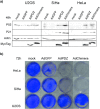Targeting the Two Oncogenic Functional Sites of the HPV E6 Oncoprotein with a High-Affinity Bivalent Ligand
- PMID: 26014966
- PMCID: PMC4512291
- DOI: 10.1002/anie.201502646
Targeting the Two Oncogenic Functional Sites of the HPV E6 Oncoprotein with a High-Affinity Bivalent Ligand
Abstract
The E6 oncoproteins of high-risk mucosal (hrm) human papillomaviruses (HPVs) contain a pocket that captures LxxLL motifs and a C-terminal motif that recruits PDZ domains, with both functions being crucial for HPV-induced oncogenesis. A chimeric protein was built by fusing a PDZ domain and an LxxLL motif, both known to bind E6. NMR spectroscopy, calorimetry and a mammalian protein complementation assay converged to show that the resulting PDZ-LxxLL chimera is a bivalent nanomolar ligand of E6, while its separated PDZ and LxxLL components are only micromolar binders. The chimera binds to all of the hrm-HPV E6 proteins tested but not to low-risk mucosal or cutaneous HPV E6. Adenovirus-mediated expression of the chimera specifically induces the death of HPV-positive cells, concomitant with increased levels of the tumour suppressor P53, its transcriptional target p21, and the apoptosis marker cleaved caspase 3. The bifunctional PDZ-LxxLL chimera opens new perspectives for the diagnosis and treatment of HPV-induced cancers.
Keywords: antitumor agents; human papillomavirus; inhibitors; peptides; protein engineering.
© 2015 The Authors. Published by Wiley-VCH Verlag GmbH & Co. KGaA. This is an open access article under the terms of the Creative Commons Attribution Non-Commercial NoDerivs License, which permits use and distribution in any medium, provided the original work is properly cited, the use is non-commercial and no modifications or adaptations are made.
Figures




Similar articles
-
PDZ Domain-Containing Protein NHERF-2 Is a Novel Target of Human Papillomavirus 16 (HPV-16) and HPV-18.J Virol. 2019 Dec 12;94(1):e00663-19. doi: 10.1128/JVI.00663-19. Print 2019 Dec 12. J Virol. 2019. PMID: 31597772 Free PMC article.
-
Structural and functional characterization of the PDZ domain of the human phosphatase PTPN3 and its interaction with the human papillomavirus E6 oncoprotein.Sci Rep. 2019 May 15;9(1):7438. doi: 10.1038/s41598-019-43932-x. Sci Rep. 2019. PMID: 31092861 Free PMC article.
-
Design of a PDZbody, a bivalent binder of the E6 protein from human papillomavirus.Sci Rep. 2015 Mar 23;5:9382. doi: 10.1038/srep09382. Sci Rep. 2015. PMID: 25797137 Free PMC article.
-
Cellular binding partners of the human papillomavirus E6 protein.Arch Virol. 2008;153(3):397-408. doi: 10.1007/s00705-007-0022-5. Epub 2008 Jan 3. Arch Virol. 2008. PMID: 18172569 Free PMC article. Review.
-
Human papillomaviruses and the specificity of PDZ domain targeting.FEBS J. 2012 Oct;279(19):3530-3537. doi: 10.1111/j.1742-4658.2012.08709.x. Epub 2012 Aug 29. FEBS J. 2012. PMID: 22805590 Review.
Cited by
-
Targeting PDZ domains as potential treatment for viral infections, neurodegeneration and cancer.Biol Direct. 2021 Oct 12;16(1):15. doi: 10.1186/s13062-021-00303-9. Biol Direct. 2021. PMID: 34641953 Free PMC article. Review.
-
Endocytosis and Transcytosis of SARS-CoV-2 Across the Intestinal Epithelium and Other Tissue Barriers.Front Immunol. 2021 Sep 7;12:636966. doi: 10.3389/fimmu.2021.636966. eCollection 2021. Front Immunol. 2021. PMID: 34557180 Free PMC article. Review.
-
Discovery of reactive peptide inhibitors of human papillomavirus oncoprotein E6.Chem Sci. 2023 Oct 25;14(44):12484-12497. doi: 10.1039/d3sc02782a. eCollection 2023 Nov 15. Chem Sci. 2023. PMID: 38020382 Free PMC article.
-
Viral Interactions with PDZ Domain-Containing Proteins-An Oncogenic Trait?Pathogens. 2016 Jan 18;5(1):8. doi: 10.3390/pathogens5010008. Pathogens. 2016. PMID: 26797638 Free PMC article. Review.
-
Mitotic control of human papillomavirus genome-containing cells is regulated by the function of the PDZ-binding motif of the E6 oncoprotein.Oncotarget. 2017 Mar 21;8(12):19491-19506. doi: 10.18632/oncotarget.14469. Oncotarget. 2017. PMID: 28061478 Free PMC article.
References
-
- Van Doorslaer K. Virology. 2013;445:11–20. - PubMed
-
- zur Hausen H. Nat. Rev. Cancer. 2002;2:342–350. - PubMed
-
- Gillison ML, Alemany L, Snijders PJ, Chaturvedi A, Steinberg BM, Schwartz S, Castellsagué X. Vaccine. 2012;30:F34–F54. - PubMed
-
- Ghittoni R, Accardi R, Hasan U, Gheit T, Sylla B, Tommasino M. Virus Genes. 2010;40:1–13. - PubMed
Publication types
MeSH terms
Substances
Grants and funding
LinkOut - more resources
Full Text Sources
Other Literature Sources
Research Materials
Miscellaneous

